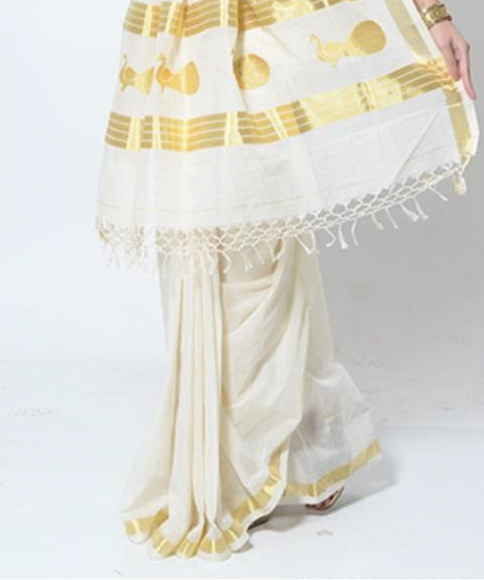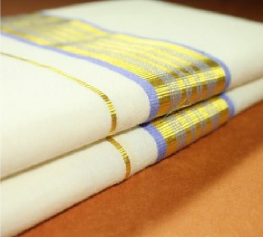Balaramapuram Saree and Doti
Balaramapuram Saree and Doti
Balaramapuram Saree
Back ground
 Balaramapuram is a small town 15 km away from Thiruvanthapuram in Kerala. The major items manufactured in Balaramapuram are Grey Saree, Dhoti (also known as Veshti or Mundu) and Set Mundu (Pudava & Kavani or Mumdum Neriyathum). These traditional products are woven with kora white cotton yarn (grey or unbleached or non-dyed yarn) of finer counts like 8os, 100s etc. The combination of Dhoti and shirt is the traditional outerwear of the adult male in Kerala. The traditional outerwear of the women folk is called Set mundu, a combination of Dhoti for covering the lower part of the body and Blouse and Kavani (or Neriyathu) to wrap around the upper portion of the body like dupatta. Pudava and Kavani is the traditional wedding dress of the brides in the southern part of the state. The Set Mundu has now taken a new form as Balarampuram Saree.
Balaramapuram is a small town 15 km away from Thiruvanthapuram in Kerala. The major items manufactured in Balaramapuram are Grey Saree, Dhoti (also known as Veshti or Mundu) and Set Mundu (Pudava & Kavani or Mumdum Neriyathum). These traditional products are woven with kora white cotton yarn (grey or unbleached or non-dyed yarn) of finer counts like 8os, 100s etc. The combination of Dhoti and shirt is the traditional outerwear of the adult male in Kerala. The traditional outerwear of the women folk is called Set mundu, a combination of Dhoti for covering the lower part of the body and Blouse and Kavani (or Neriyathu) to wrap around the upper portion of the body like dupatta. Pudava and Kavani is the traditional wedding dress of the brides in the southern part of the state. The Set Mundu has now taken a new form as Balarampuram Saree.
Material used
The materials used for their weaving are cotton and Kasavu (or Zari). Kasavu is the Malayalam name of “Zari”; a silk thread twisted with a thin silver wire and electroplated in gold. Specialty of the saree lies in preparation of the warp thread which is sized (starched) with the help of brush. The threads become almost round in shape after sizing so the saree has very clear surface without any superfluous or extra fibres protruding on it.
Technique applied
The weavers use a unique technique by which each wrap thread is separately controlled by hand to interlace with the weft wound in small pirns. But the Butta and larger type extra weft designs are woven on the motif/pattern printed with wooden blocks using easily washable vegetable colors. Then, each motif has to be threaded individually following the contour of the printed design by skilled weavers. This kind of work is easily distinguished from Jacquard/ jala designs as both sides of the fabric will have the identical appearance and not merely an outline on the back side as in case of normal weaving. For zari in the cross border of the fabric, rib weave is used with the help of treadle connected with extra cords. Due to this weave, there is a series of horizontal ribs (cross bar effect) in the cross border of the product. ‘Balaramapuram’ became the synonym for the above type of handloom fabrics.
How to distinguish genuine Balarampuram Saree
- Design appears very prominently on the sari because of rib weave.
- Design appears identical on both sides of the fabric. There is no rough or unfinished-like appearance on the back side of the fabric.
- Basic texture i.e., thread density of the fabric is higher than that of similar cotton sarees.
- Less starchy finish in the saree so it is softer to touch.
Balaramapuram Dhoti
Back ground
 Balaramapuram is a small town 15 km away from Thiruvanthapuram in Kerala. The major items manufactured in Balaramapuram are Grey Saree, Dhoti (also known as Veshti or Mundu) and Set Mundu (Pudava&Kavani or MumdumNeriyathum). These traditional products are woven with kora white cotton yarn (grey or unbleached or non-dyed yarn) of finer counts like 8os, 100s etc. The combination of Dhoti and shirt is the traditional outerwear of the adult male in Kerala. The traditional outerwear of the women folk is called Set mundu, a combination of Dhoti for covering the lower part of the body and Blouse and Kavani (or Neriyathu) to wrap around the upper portion of the body like dupatta. Pudava and Kavani is the traditional wedding dress of the brides in the southern part of the state. The Set Mundu has now taken a new form as BalarampuramSaree.
Balaramapuram is a small town 15 km away from Thiruvanthapuram in Kerala. The major items manufactured in Balaramapuram are Grey Saree, Dhoti (also known as Veshti or Mundu) and Set Mundu (Pudava&Kavani or MumdumNeriyathum). These traditional products are woven with kora white cotton yarn (grey or unbleached or non-dyed yarn) of finer counts like 8os, 100s etc. The combination of Dhoti and shirt is the traditional outerwear of the adult male in Kerala. The traditional outerwear of the women folk is called Set mundu, a combination of Dhoti for covering the lower part of the body and Blouse and Kavani (or Neriyathu) to wrap around the upper portion of the body like dupatta. Pudava and Kavani is the traditional wedding dress of the brides in the southern part of the state. The Set Mundu has now taken a new form as BalarampuramSaree.
Material used
The materials used for their weaving are cotton and Kasavu (or Zari). Kasavu is the Malayalam name of “Zari”; a silk thread twisted with a thin silver wire and electroplated in gold. Cotton of count 80-100’s is used in both warp and weft.
Technique applied
The weavers use a primitive type of throw-shuttle pit looms for the production of exclusively cotton fabrics with pure zari. They do not use any type of improved appliances such as Dobby, Jacquard, Jala, etc. for the production of dhoti.
How to distinguish genuine Balarampuram dhoti
- Design appears very prominently on the dhoti because of rib weave.
- Design appears identical on both sides of the dhoti. There is no rough or unfinished-like appearance on the back side of the fabric.
- Basic texture i.e., thread density of the fabric is higher.
- Less starchy finish in the dhoti makes it softer to touch.
Source : Indian Handloom Brand
Last Modified : 9/4/2023
This topic provides information about Venkatagiri ...
This topic provides information about Tweed.
This topic provides information about Tussar Gichh...
This topic provides information about Pochhampally...
